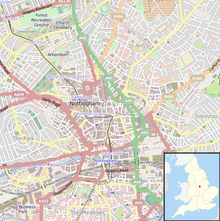St Mary's Gate, Nottingham
 27 St Mary’s Gate | |
| Maintained by | Nottingham City Council |
|---|---|
| Coordinates | 52°57′6.4″N 1°8′39.41″W / 52.951778°N 1.1442806°W |
St Mary’s Gate is a historic street in the Lace Market area of Nottingham City Centre between High Pavement and Warser Gate.
History[edit]
The early name for the street was Seynt Maregate (Latin: Via Beatae Mariae),[1] taking its name from St Mary's Church which is at the southern end. In the late Middle Ages the street housed workshops for the production of Nottingham alabaster.
The street housed the old Theatre Royal which was built in 1760 on the site of an older establishment.[2] It was held on lease for many years by Robertson and Manly, managers of a company of comedians who visited Nottingham three or four times per year. The theatre was sold in 1854 to J.F. Saville[3] for £1,950 (equivalent to £231,200 in 2023).[4] The theatre was converted by Richard Middleton into Middleton’s Royal Alhambra Music Hall in 1865, when the new Theatre Royal was opened in Parliament Street. In 1880 the owner of the Royal Alhambra Music Hall, John Betts Wigley was charged with assaulting and beating a comedian William White.[5] The Music Hall closed in 1883 when the Nottingham Magistrates’ refused a theatrical licence.[6]
Notable buildings[edit]
- 1-17 Adams Building 1854-75 by Thomas Chambers Hine
- 5-47, Halifax Place flats, 1981-83 by Peter Hill[7]
- 27 House, late 18th century.[8] It was built in 1849 for Louis Augustin Baillon, the Vice Consul of France, as Consulate Offices. In 1860s it was adapted into a Lace warehouse.
- 35 and 37 Warehouse 1880[9]
- 46 Kean's Head Public House. Formerly warehouse and offices 1907 by Robert Evans JP, Robert Evans (Jun), and J Wollatt.[10]
- 48 to 50 Lace Warehouse, 1883 by S & J Cargill.[11] now offices
- 49 House,[12] now offices
References[edit]
- ^ Records of the Borough of Nottingham. Vol 1. 1155-1399. Thomas Forman & Sons, Nottingham. 1882. p. 438.
- ^ Holland Walker, J (1928). "An itinerary of Nottingham". Transactions of the Thoroton Society. 32: 6. Retrieved 31 December 2017.
- ^ "Sale of the Theatre Royal, Nottingham". Nottinghamshire Guardian. England. 26 January 1854. Retrieved 31 December 2017 – via British Newspaper Archive.
- ^ UK Retail Price Index inflation figures are based on data from Clark, Gregory (2017). "The Annual RPI and Average Earnings for Britain, 1209 to Present (New Series)". MeasuringWorth. Retrieved 7 May 2024.
- ^ "Extraordinary fracas at the Royal Alhambra". Nottingham Evening Post. England. 27 November 1880. Retrieved 27 December 2017 – via British Newspaper Archive.
- ^ "The Application for a Theatrical License for the Alhambra". Nottingham Evening Post. England. 28 March 1883. Retrieved 27 December 2017 – via British Newspaper Archive.
- ^ Harwood, Elain (2008). Pevsner Architectural Guides. Yale University Press. p. 105. ISBN 9780300126662.
- ^ Historic England, "27 St Mary's Gate (1270503)", National Heritage List for England, retrieved 31 December 2017
- ^ Historic England, "35 and 37 St Mary's Gate (1255114)", National Heritage List for England, retrieved 31 December 2017
- ^ Historic England, "46 St Mary's Gate (1255008)", National Heritage List for England, retrieved 31 December 2017
- ^ Historic England, "48 and 50 St Mary's Gate (1255009)", National Heritage List for England, retrieved 31 December 2017
- ^ Historic England, "5 Kayes Walk, 49 St Mary's Gate (1255009)", National Heritage List for England, retrieved 31 December 2017

